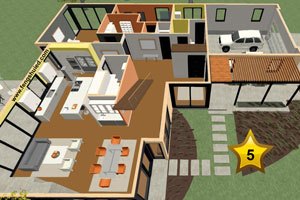Unless you have your own elevator at home, a staircase is a mainstay if the house is anything more than single storey.
Elevators are actually necessary in some households when there are residents who have problems with climbing the stairs.
Even if you have a private lift at home, the odds are that you will have a staircase too.
What homeowners don’t often pay attention to is that the staircase is a very hazardous structure in the house. A huge portion of accidents that occur at home involves the staircase.
This is why the safety aspects of a staircase should be a focal point instead of aesthetic design.
Feng shui should be secondary.
The irony is that if the feng shui of the staircase is bad, there is going to be a higher likelihood of accidents that lead to injuries in the area.
Here are some important feng shui considerations to take note about staircase construction.
1) Type of staircases
There are basically 4 common types of staircases constructed in residential homes for movement from one level to another.
- Straight stairs
- L-shaped stairs
- Spiral stairs
- Curved stairs
Among them, curved staircases is the preferred choice for feng shui.
It don’t induce energy to move in a straight line, it has no corners that can create sha chi, and it directs energy to move in a curved manner which is often deemed as auspicious.
Don’t confuse spiral staircases with curved ones.

While there are feng shui masters who insist that spiral staircases resemble the dragon, it also resembles a drill boring into the very heart of the house.
If curved staircases are not possible, then go with L-shaped followed by straight ones that are not too steep.
If you must use a spiral staircase, at least use wood material and avoid metal as much as possible unless it’s in the north sector.
2) See through steps
Sometimes, for design purposes or budgeting reasons, staircases are built without risers.
This allows people to see through the staircase, including what’s behind and under it.

Such staircases with “holes” signifies not just a loss of wealth, but also creates an unnecessary source of sha chi in the house.
On top of that, it sure doesn’t offer peace of mind when running up the stairs.
Be mindful that should a step break when you put your weight on it, it is not just going to be a single step fall. It can result in falling down the whole flight of stairs.
3) Choosing material
The most common materials used for the construction of staircases are:
- Wood
- Gemstone
- Concrete
- Metal
If you have feng shui OCD, you might want to analyze the base element of the area where the staircase is located.
Always use solid material and remember laws of the 5 elements.
4) Poison arrows
There are 2 main sources of sha chi that can emit from staircases.
- Saw blade
- Scissors
The saw blade refers to the jagged steps that can be observed from the side resembling the teeth of the hacksaw.

The scissors describe the sharp angle of staircases that is especially apparant with straight staircases.
There should be no seats that has the back facing these parts of the staircase. So take note the position of the sofa and dining table.
The teeth should be ideally hidden from sight with a construction of board. Of if the structure allows, the pasting of stickers.
If there is space below the staircase, use it for storage only.
Do not set up a workstation or place wealth items and books underneath the stairs.
Water features or aquariums under the staircase will induce bad luck for descendants.
5) Staircase location
If you have the luxury of determining the location of the staircase, the keep these factors in mind.
- It should not be directly facing any doors (this applies to both upper and lower floors)
- Avoid locating it at the center of the house
- The exit of the staircase on the second floor is essentially the main door to the second floor
- If the staircase leads straight to a door, then ensure that there is adequate flat space in front of the door for it to swing open (this applies even if the door swings inwards)
Do give the location considerable thought because it would be hard to relocate it in the future.
6) Workmanship
If you take a look at the design plan of staircases, you might be shocked at the level of details that go into them.
But the quality of staircases is often not about how badly designed they are. It’s more about how good or bad the workmanship is.
So if possible, do regularly inspect the staircase during the work-in-progress if possible.
This might seem like common sense. But you would be shocked at the number of houses that don’t have steady footings due to bad workmanship.
7) Pictures
The walls along the walkway of the staircase is a great place to hang pictures.
They help energy passing through to slow down and gently meander.
Just ensure that they are properly secured to the wall.
8) Railings
Minimalist home design concepts sometimes intentionally exclude railings of staircases.
An interior designer might insist that it’s all about design. You wouldn’t hear one talking about the costs that he would save.
Railings and balusters give people a feeling of security and safety when climbing up and down stairs.
There is also the aspect of basic safety to be happy about.
If feng shui is a concern, make sure that there are railings for the staircase.















